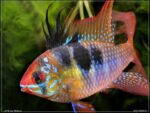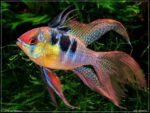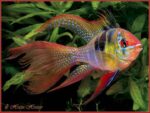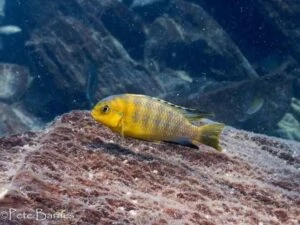Mikrogeophagus ramirezi – Ram
Meyers and Harry described the Mikrogeophagus ramirezi in 1948. They belong to the Cichlid family. Mikro is Greek and means “small”. Geophagus consist out of 2 sections, Geo in Greek meaning “Earth” and Phagein means “to eat”. Together this means little dirt-eater. The name ramirezi was already used for this species before it was described. The name is in honour of Manuel Vicente Ramirez. He caught the type specimen together with Herman Blass. Blass bred and popularized the strain. He used the names “Ramirezi” and “Ramirezi Cichlid” for this. The authors of the scientific description have continued this name to avoid confusion.
Due to the hustle with the genus, this fish has already had lots of names such as:
- Microgeophagus ramirezi (written with c instead of k)
- Apistogramma ramirezi
- Papiliochromis ramirezi
- Papilochromis ramirezi
and now as Mikrogeophagus ramirezi.
Description
One of the most beloved species in the hobby, the Mikrogeophagus ramirezi or the Ram is a sight for the eye. It also has interesting behaviour and is a social fish, meaning it leaves the other inhabitants of your tank alone. The males have an extended first ventral fin and the dorsal spines have elongated filaments. The dorsal fin is elongated and pointed whereas the females have a round-shaped dorsal fin. When the females are ready to mate they will get a reddish/pink spot on their bellies. There are different species available in the aquatic trade such as the Longfin or Electric Blue as shown in the pictures.



Sadly enough, this species is often sold as a fish for beginners in the hobby, which is not the case. The Ram requires a pH level of less than 6. This is not a general value for a community tank or a beginner’s fish. Due to this specific level of pH, there is quite a lot of fatalities among Mikrogeophagus ramirezi with beginners. An alternative to the Mikrogeophagus ramirezi might be the Mikrogeophagus altispinosus, which has subtler coloring but has even fun behavior to watch.
Character
The ram is best kept as couples or when kept in a small group a coupe will form. A couple will hold a territory that is quite large in regards to the size of the fish. So it’s better not to hold 2 males in a tank less than 1.2 metres. Females will also join the fight in defending their territory.
You can keep them with other easy-going and docile fish that are not too big. You can find them predominantly in the lower or bottom layers of the tank so this could be a threat for other bottom-dwelling fish such as Corydoras.
Biotope
The first specimens were caught in the Orinoco river delta in Venezuela. The Llanos is a vast system of tropical savannah grasslands, seasonally flooded plains and forests covering an area measuring almost 600,000 square kilometres in Venezuela and Colombia. During May there is seasonal flooding creating a large marshland.
Diet
As the scientific name already indicates, this little fish is benthophagous meaning it will take a bite of the soil and sift it with its guiles for anything edible, spitting out the gravel or sand.
They will eat all small fresh foods such as mosquito larvae, daphnia and artemia but also frozen foods and flakes are consumed. Feeding diverse foods will enhance their colouring. Best is also to feed on different places in the tank, as they are slow feeders, other faster and bigger fish, might eat everything before these fish get to it.
Animals that have been caught in the wild may refuse flakes or tabs but after an adjustment period, they will eventually start eating dried foods. For these fish, it is necessary to provide sufficient live fare to bridge this period.
The Aquarium
For the Mikrogeophagus ramirezi a 60-centimetre tank is a bare necessity. The tank needs to be set with enough hideouts and plants need to provide sufficient cover. As a substrate, you can use sand, as this is the soil close to their natural habitat. Use wood and branches to create hideouts and dark spaces where the fish can relax. Make sure there are some flat rocks on which eggs can be deposited.
Leaf litter is welcomed as this is natural to their original habitat and it created additional hideouts. This is not the only advantage these leaves have. They provide nutrition to the small fry of the Mikrogeophagus ramirezi. Also, the decomposing leaves release acids in the water which are beneficial to these delicate fish and which elevate global water quality.
As mentioned before, these fish are very sensitive to any change in water quality so regular water changes are a must. They swim in the lower and middle water layers.
Water parameters
Temperature: 25 – 28 °C
PH: 5 – 6
GH: 0 – 4
As mentioned, these fish are very sensitive to water quality. To measure the waste in the water the Redox can be calculated.
Breeding Mikrogeophagus ramirezi
Breeding Rams is quite easy when you have healthy fish. Make sure the parents are well fed. Breeding wild-caught Mikrogeophagus ramirezi can be a bit more difficult. They need really soft and acidic water for the eggs to hatch.
They are substrate spawners, the female will lay her eggs on different spots in the tank. Around 200 eggs will be deposited on plants, dimples in the substrate, rocks or ornaments. Both parents will defend their nest vigorously.
The best practice is to use a breeding tank with a sand substrate, some Java moss and rocks. You want nearly no current in the tank and dimmed lighting. The parents dig small pits in the substrate for the fry to look for microscopic food. The parents move the fry from pit to pit. They pick up the fry in their mouth to move them.
The newly hatched Rams are very tiny. You can feed them with infusoria or micro worms at first. As they get a little bigger, you can switch to newly hatched brine shrimp.
Never feed the parents daphnia, as this resembles their fry too much. When there is no more parental care the parents can be transferred back to their tank.
Video
Author
Coby – J. de Lange
Copyright images
J. de Lange
Hristo Hristov
Resources





























Reviews
There are no reviews yet.